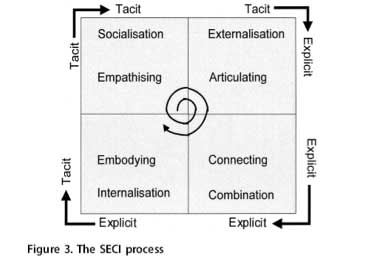 In the introduction to their book „Managing Flow, A Process Theory of the Knowledge-Based Firm“, Nonaka/Toyama/Hirata are very sceptical about the use of IT for knowledge management. They write: „In the world of business practice, knowledge management first took the form of heavy investment in information technologies (IT), an approach that turned out to be painfully ineffective, if not a downright failure. This was the result of the major misunderstanding that knowledge management is only about the efficient storage, transfer, and use of information, and the term "management" itself was misconstrued as the simple administration or supervision of information systems. In fact, knowledge is different in nature from information or physical resources, and unless we understand the essential nature of knowledge, we cannot share or use it, and, more importantly, create it effectively.“
In the introduction to their book „Managing Flow, A Process Theory of the Knowledge-Based Firm“, Nonaka/Toyama/Hirata are very sceptical about the use of IT for knowledge management. They write: „In the world of business practice, knowledge management first took the form of heavy investment in information technologies (IT), an approach that turned out to be painfully ineffective, if not a downright failure. This was the result of the major misunderstanding that knowledge management is only about the efficient storage, transfer, and use of information, and the term "management" itself was misconstrued as the simple administration or supervision of information systems. In fact, knowledge is different in nature from information or physical resources, and unless we understand the essential nature of knowledge, we cannot share or use it, and, more importantly, create it effectively.“
What then is the role of IT in knowledge management, if any? Let us at first look at the type of knowledge that is created in the different phases of knowledge management using Nonaka´s SECI-model (all figures see SECI, Ba and Leadership: a Unified Model of Dynamic Knowledge Creation, by Nonaka/Toyama/Konno, Long Range Planning, 33 (2000), 5-34).
Clearly, there is no room for IT in the first phase: in the Socialisation Phase tacit knowledge is converted through shared experiences. Tacit knowledge is difficult to formalize and can only be acquired through shared experience in real-life. In the Externalization Phase tacit knowledge is articulated so that the resulting explicit knowledge can be shared. This typically done in small groups using metaphor, analogy and graphical models. In this phase the flip-chart and other creativity techniques are the method of choice, and non-verbal communication is best supported if the team is in the same place. Similary, the Internationalisation Phase offers limited IT opportunities, as here the explicit knowledge is internalized through training and learning by doing.
However, IT can help in the Combination Phase. Here, additional explicit knowledge is collected from inside and outside of the organization, the initial concept is dissiminated, enriched and validated. Here the strenght of computerized information systems can be leveraged: they allow easy dissemination of information to large groups and allow asynchronous, yet integrated management of explicit knowledge encoded in text and other data types.

Knowledge creation and conversion needs a shared context, called „Ba“ by Nonaka/Toyama/Konno, through which the individuals can interact. In accordance with the four phases in the SECI cyle, four types of Ba can be distinguished, each one tailored to the management of particular types of knowledge assets.


Knowledge creation in a Ba is done through dialogue, involving the expression of arguments about goals, hypotheses and actions and their evaluation through discussion, Out of this process commonly accepted knowledge assets emerge. Typically, originating and dialoguing Bas are physical spaces, while xercising Bas can be virtual e-learning solutions and systemising Bas can be virtual spaces, where digitalized knowledge assets are created. How should such a digital systemising Ba be constructed? Here is the way we approached this issue for discuto:
Looking at the systemic knowledge assests of Nonaka/Toyama/Konno, the unifying information structure is the document, where a database is just a document of facts. A systemising Ba should therefore be based on the discussion and transformation of documents. A common virtual space is created through an Internet portal where the current status of the process (document version, comments, votes, background information) is available to all participants. The document structure is used to structure the different arguments, i.e. comments are attached to paragraphs, both of which are seen as arguments. An important component is the evaluation of arguments. Only voting can give a direction to the discussion. The way to a document that better reflects the goals and experiences of the participants is also supported by the consensus algorithm, which indicates desirable modifications of the knowledge asset document.

